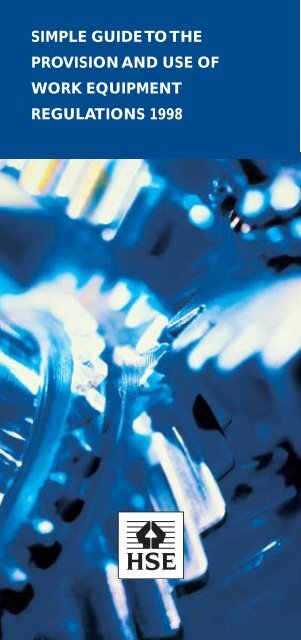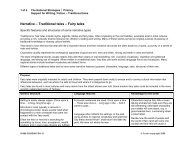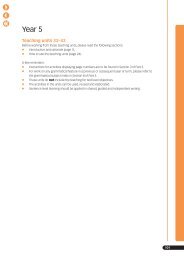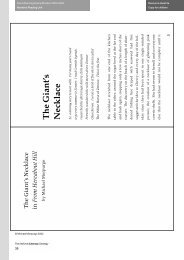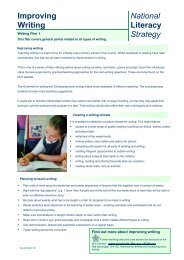PROVISION AND USE OF WORK EQUIPMENT REGULATIONS 1998
Simple guide to the provision and use of work equipment ...
Simple guide to the provision and use of work equipment ...
You also want an ePaper? Increase the reach of your titles
YUMPU automatically turns print PDFs into web optimized ePapers that Google loves.
SIMPLE GUIDE TO THE<strong>PROVISION</strong> <strong>AND</strong> <strong>USE</strong> <strong>OF</strong><strong>WORK</strong> <strong>EQUIPMENT</strong><strong>REGULATIONS</strong> <strong>1998</strong>
IntroductionThis guide provides information about the legalrequirements of the Provision and Use of WorkEquipment Regulations <strong>1998</strong> (PUWER) which cameinto force on 5 December <strong>1998</strong>.It gives a general indication of some of the mainrequirements of the Regulations. However, it isimportant that you refer to the Regulations andaccompanying Approved Code of Practice tofamiliarise yourself fully with your duties (see Furtherinformation at the back of the leaflet).What is PUWER?PUWER replaces the Provision and Use of WorkEquipment Regulations 1992 and carries forwardthese existing requirements with a few changes andadditions, for example the inspection of workequipment and specific new requirements for mobilework equipment. Many aspects of PUWER shouldtherefore be familiar to you.The Regulations require risks to people’s health andsafety, from equipment that they use at work, to beprevented or controlled. In addition to therequirements of PUWER, lifting equipment is alsosubject to the requirements of the Lifting Operationsand Lifting Equipment Regulations <strong>1998</strong> (see Furtherinformation).What does PUWER do?In general terms, the Regulations require thatequipment provided for use at work is:■■■■suitable for the intended use;safe for use, maintained in a safe condition and,in certain circumstances, inspected to ensurethis remains the case;used only by people who have received adequateinformation, instruction and training; andaccompanied by suitable safety measures,eg protective devices, markings, warnings.
What equipment is covered by the Regulations?Generally, any equipment which is used by anemployee at work is covered, for example hammers,knives, ladders, drilling machines, power presses,circular saws, photocopiers, lifting equipment (includinglifts), dumper trucks and motor vehicles. Similarly, ifyou allow employees to provide their own equipment,it too will be covered by PUWER and you will need tomake sure it complies.Work equipment must meet all the requirements ofthe Regulations from 5 December <strong>1998</strong>. However,requirements relating to certain aspects of mobilework equipment (see below) do not apply to suchequipment (provided for use in the business before5 December <strong>1998</strong>) until 5 December 2002. HSEinformation sheet MISC156 should be read if youuse hired mobile work equipment, see Furtherinformation.Examples of uses of equipment which are covered bythe Regulations include starting or stopping theequipment, repairing, modifying, maintaining, servicing,cleaning and transporting.Do the Regulations apply to me?If you are an employer or self-employed person andyou provide equipment for use at work, or if you havecontrol of the use of equipment, then the Regulationswill apply to you.They do not apply to equipment used by the public, forexample compressed air equipment used in a garageforecourt. However, such circumstances are coveredby the Health and Safety at Work etc Act 1974 (HSWAct).While your employees do not have duties underPUWER, they do have general duties under the HSWAct and the Management of Health and Safety at WorkRegulations 1999 (MHSWR), for example to takereasonable care of themselves and others who may be
affected by their actions, and to co-operate withothers.The Regulations cover places where the HSW Actapplies - these include factories, offshore installations,offices, shops, hospitals, hotels, places ofentertainment etc. PUWER also applies in commonparts of shared buildings and temporary places ofwork such as construction sites. While theRegulations cover equipment used by people workingfrom home, they do not apply to domestic work in aprivate household.What do the Regulations require me to do?You must ensure that the work equipment youprovide meets the requirements of PUWER. In doingso, you should ensure that it is:■■■suitable for use, and for the purpose andconditions in which it is used;maintained in a safe condition for use so thatpeople’s health and safety is not at risk; andinspected in certain circumstances to ensurethat it is, and continues to be, safe for use. Anyinspection should be carried out by a competentperson (this could be an employee if they havethe necessary competence to perform the task)and a record kept until the next inspection.You should also ensure that risks, created by the useof the equipment, are eliminated where possibleor controlled by:■■taking appropriate ‘hardware’ measures, egproviding suitable guards, protection devices,markings and warning devices, system controldevices (such as emergency stop buttons) andpersonal protective equipment; andtaking appropriate ‘software’ measures suchas following safe systems of work (eg ensuringmaintenance is only performed when equipmentis shut down etc), and providing adequateinformation, instruction and training.
A combination of these measures may be necessarydepending on the requirements of the work, yourassessment of the risks involved, and the practicabilityof such measures.You need to ensure that people using workequipment have received adequate training,instruction and information for the particularequipment.Mobile work equipmentIn addition to these general requirements which applyto all work equipment, Part III of PUWER containsspecific duties regarding mobile work equipment, forexample fork-lift trucks and dumper trucks.You should ensure that where mobile workequipment is used for carrying people, it is suitable forthis purpose. Measures should be taken to reduce therisks (eg from it rolling over) to the safety of thepeople being carried, the operator and anyone else.Power pressesPart IV of the Regulations also contains specificrequirements regarding power presses. In particular,you should have a power press, and associated guardor protection device, thoroughly examined atspecified intervals and inspected daily in use toensure that it is safe. This work should only beperformed by a competent person; records shouldbe kept.How do the Regulations relate to other healthand safety legislation?The requirements of the Regulations need to beconsidered alongside other health and safety law.For example, section 2 of the HSW Act requiresall employers to ensure, so far as is reasonablypracticable, the health, safety and welfare of all theiremployees. Similarly, the MHSWR contain importantduties relating to the carrying out of a risk assessment
to identify measures that you can take to eliminate, orreduce, the risks presented by the particular hazardsin your workplace. Guidance on how to do this is setout in 5 steps to risk assessment (see Furtherinformation).Other more specific legislation may also apply, forexample :■■The Workplace (Health, Safety and Welfare)Regulations 1992, which cover, for example,workplace risks to pedestrians from vehicles;The Construction (Health, Safety and Welfare)Regulations 1996 which contain, for example,specific requirements relating to certain types ofwork equipment such as scaffolding.Generally, if you are meeting the requirements ofmore specific legislation such as those outlined above,then this should normally be sufficient to meet themore general requirements of PUWER.How are the Regulations enforced?Health and safety inspectors enforce the Regulations.If you have duties under PUWER you will be giventime to assimilate the requirements which are new.However, where there are serious risks, or therequirements are not new, inspectors will beprepared to take firm enforcement action.Because of the particular problems faced by hirecompanies in meeting the requirements of regulations26 and 27 of PUWER (ie taking appropriate action tominimise the risks from mobile work equipmentrolling over), inspectors will adopt a practicalapproach to enforcement. Advice is given in HSEinformation sheet Hiring and leasing out of plant:application of PUWER 98, regulations 26 and 27(see Further information).
Further informationThe following publications are available from HSEBooks:Safe use of work equipment. Provision and Use of WorkEquipment. Provision and Use of Work EquipmentRegulations <strong>1998</strong>. Approved Code of Practice andGuidance L22 HSE Books <strong>1998</strong> ISBN 0 7176 1626 6Safe use of power presses. Provision and Use of WorkEquipment Regulations <strong>1998</strong> as applied to power presses.Approved Code of Practice and Guidance L112HSE Books <strong>1998</strong> ISBN 0 7176 1627 4Safe use of woodworking machinery. Provision and Use ofWork Equipment Regulations <strong>1998</strong> as applied towoodworking. Approved Code of Practice and GuidanceL114 HSE Books <strong>1998</strong> ISBN 0 7176 1630 4Safe use of lifting equipment. Lifting Operations and LiftingEquipment Regulations <strong>1998</strong>. Approved Code of Practiceand Guidance L113 HSE Books <strong>1998</strong>ISBN 0 7176 1628 2Five steps to risk assessment Leaflet INDG163(rev1)HSE Books <strong>1998</strong> (single copy free or priced packs of10 ISBN 0 7176 1565 0)Managing vehicle safety at the workplace: A short guidefor employers Leaflet INDG199 HSE Books 1995(single copy free or priced packs of 10ISBN 0 7176 0982 0)Buying new machinery: A short guide to the law and someinformation on what to do for anyone buying newmachinery for use at work Leaflet INDG271HSE Books <strong>1998</strong> (single copy free or priced packsof 15 ISBN 0 7176 1559 6)Managing health and safety: Five steps to success LeafletINDG275 HSE Books <strong>1998</strong> (single copy free or pricedpacks of 10 ISBN 0 7176 2170 7)Simple guide to the Lifting Operations and LiftingEquipment Regulations <strong>1998</strong> Leaflet INDG290 HSEBooks 1999 (single copy free or priced packs of 15ISBN 0 7176 2430 7)Workplace transport safety: Guidance for employersHSG136 HSE Books 1995 ISBN 0 7176 0935 9Hiring and leasing out of plant: application of PUWER 98,regulations 26 and 27 MISC156 HSE Books <strong>1998</strong>
While every effort has been made to ensurethe accuracy of the references listed in thispublication, their future availability cannotbe guaranteed.HSE priced and free publications are availableby mail order from HSE Books, PO Box 1999,Sudbury, Suffolk CO10 2WATel: 01787 881165 Fax: 01787 313995Website: www.hsebooks.co.uk (HSE pricedpublications are also available from bookshopsand free leaflets can be downloaded fromHSE’s website: www.hse.gov.uk.)For information about health and safetyring HSE’s Infoline Tel: 08701 545500Fax: 02920 859260 e-mail:hseinformationservices@natbrit.com or writeto HSE Information Services, CaerphillyBusiness Park, Caerphilly CF83 3GG.This leaflet is available in priced packs of 15from HSE Books ISBN 0 7176 2429 3. Singlefree copies are also available from HSE Books.© Crown copyright This publication may befreely reproduced, except for advertising,endorsement or commercial purposes.The information is current at 4/99.Please acknowledge the source as HSE.Printed and published by the Health andSafety ExecutiveINDG291 Reprinted 6/04 C300


